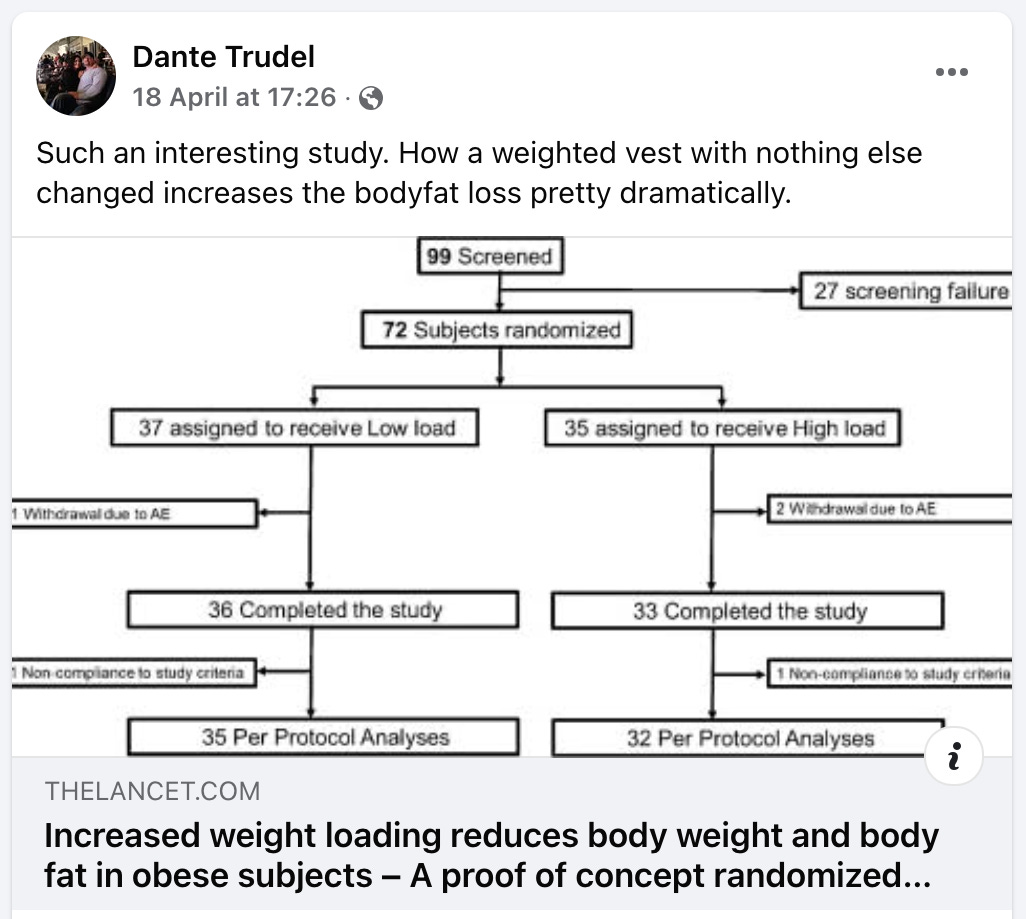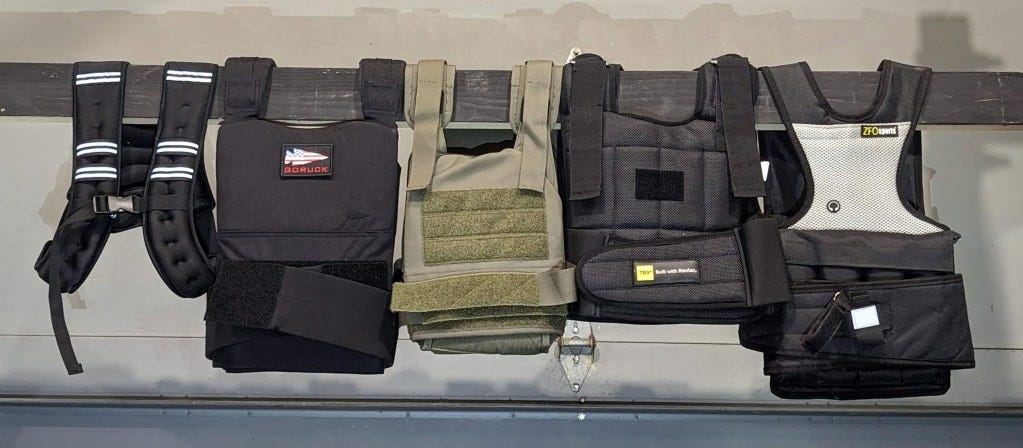Research Review - Weighted Vests & Weight Loss
Does adding weight remove weight? This study says yes, but why?
At this point, there are people I’ve followed online for decades. From the old days of message boards and forums to current social media sites, one of these people is a guy named Dante Trudel. He’s always been consistent with quality hardcore training talk, logical nutrition information, and as an owner of True Nutrition, a protein supplement company, makes great posts as an industry insider as well.
Recently, he posted this:
Normally this headline wouldn’t completely catch my eye, but I’ve been in the market for a weighted vest for a few weeks now, so it did. I made the move to click on the study link, read the whole thing, and now I’m relaying what I’ve learned to you. So, let’s talk about this study!
When I first read the title of this study, I thought, ‘Duh, isn’t it obvious that suddenly adding weight to someone and making them stand more often would cause them to burn more calories each day, consequently causing them to lose weight? I mean, provided that nothing else changed in their daily routine, this just seems like a given. What’s the point of this study?’
But, as I continued to read further, I realized that these researchers were coming at this from a different angle. This term I’d never heard of before kept coming up; gravitostat. I thought, ‘What the heck is gravitostat and what does it mean?’ It sounds like an advanced tool used to save the world in a Marvel movie. In reality, the definition is:
Gravitostat - A proposed body weight homeostatic mechanism that regulates body weight and fat mass, particularly in the lower extremities, independently of the hormone leptin. It is suggested to work by sensing weight in the lower extremities, sending signals to the central nervous system, and ultimately reducing body weight and fat mass.
Since leptin was mentioned, I want to explain what that is as well. Leptin is a hormone, mainly produced by your fat cells, that helps regulate appetite and body weight by signaling to your brain that you're full. You can see how your body’s production of leptin can influence how much you eat, which influences bodyweight and fat mass.
This study is implying that the gravitostat and leptin body weight regulation mechanisms are different and independent from one another. I thought that was important to note and explain before going forward.
Personally, this whole concept of our body containing sensors that detect added weight, and those sensors are likely within our lower body bones, is brand new to me. Truthfully, I’m not sure I’m sold on it. It’s certainly possible that the gravitostat mechanism exists, but there’s also another perfectly good explanation for why wearing a weighted vest would cause weight loss. I’ll get into this later on, but what do you think?
It All Started With Mice
Most studies done on humans are prefaced with studies done on animals. Mice are certainly popular subjects for these studies and this case is no exception. In an experiment on obese mice, researchers found that those who consumed weighted capsules did see a reduction in body weight over time. I did not read the full mice study, but you are certainly welcome to, if you wish.
With the findings of this study on their minds, the scientists behind our featured study went to work. They recruited a group of human participants and screened them to make sure they fit multiple pre-determined requisites. Here’s the excerpt from the paper itself:
Healthy men and women with mild obesity (degree 1 obesity, BMI > 30 and ≤ 35 kg/m2), between 18 and 70 years of age, willing to comply with the study protocol, with normal or clinically non-significant aberrations of screening blood- and urine samples and signed informed consent were eligible for participation. The exclusion criteria were the following: chronic disease that hardens the participation in the study as judged by the investigator, chronic pain, regular consumption of medicine or natural supplements that affect weight, inhibit physical activity or increase the risk of adverse effects as judged by the investigator, bariatric-metabolic operation, reduced mobility, pregnancy, change in body weight of 5 kg or greater during the past 3 months, a greater than 1.5 kg difference in body weight between the screening visit and the baseline visit, drastic change in lifestyle during the last three months (change in physical activity or nicotine or alcohol use), or apparent risk of not being able to comply with the study protocol for any reason as judged by the investigator.
I debated including such a lengthy detail of how they screened their participants, but I think it’s good to see just how stringent they were in choosing who was studied and who wasn’t.
Once the group of participants had been established, they provided a portion of them with a weight vest equal to 11% of their bodyweight and the remaining with a vest equal to 1% of their bodyweight.
They were told to wear their vest roughly eight hours per day and to otherwise live their life as they normally would, except for one addition. They were told to stand for a certain portion of those eight vest-wearing hours per day.
Since nutrition plays a huge role in weight loss, each participant completed nutrition questionnaires to ensure food and alcohol consumption were kept in check. Also, drug use was prohibited.
The trial period for this study lasted three weeks.
Considering everything above, here’s how the participants faired:
We can see that out of the 99 screened, 72 made it into the study, 3 withdrew due to adverse events, 69 completed the study, and a couple failed to comply. In the end, data from 67 subjects was analyzed.
The Findings
The results of this study are clearly shown by the following graphic:
In summary, the high load group clearly shows more weight loss than the low load group.
The high load group also displays more fat mass loss than the low load group.
Finally, when it comes to changes in fat free mass, there is not a significant change in either group. At the same time, it’s worth noting the trend, which is the high load group showing an increase in fat free mass.
In my opinion, this is likely in the form of muscle, considering the high load group is performing resistance training to a certain degree when they’re wearing their vests.
Do these results surprise you? Without knowing the gravitostat concept even exists, they don’t surprise me at all.
Let’s Discuss
Earlier I said this, ‘Truthfully, I’m not sure I’m sold on it. It’s certainly possible that the gravitostat mechanism exists, but there’s also another perfectly good explanation for why wearing a weighted vest would cause weight loss.” Now that I’ve outlined the basics of this study, along with it’s core findings, I’d like to explain myself.
The reason I’m not sold on the gravitostat mechanism is the same reason I’m not at all surprised by the weight loss results of people wearing weighted vests, adding standing time to their lifestyles, and not changing anything with their diets. In short, they worked harder, moved more, and lost weight.
Was this due to the gravitostat mechanism or can we chalk it up to increased daily caloric burn? I honestly don’t know how to tell and I don’t think the researchers behind this study have a definitive answer either.
Based on what I read about the researchers’ view of the gravitostat mechanism, they see it, essentially, as a sensor in the lower body that takes action when a sudden addition of weight is applied. Since the body prefers homeostasis (remaining the same), this mechanism theoretically influences leptin production (remember, leptin makes us feel full) to reduce appetite, resulting in fewer calories consumed and subsequent weight loss. That subsequent weight loss offsets the weight addition, maintaining body weight homeostasis.
I believe the gravitostat mechanism does make sense if its sensors are able to influence leptin production in the body. In my opinion, a study that focused on leptin levels during an identical weighted vest protocol would be hugely valuable for the gravitostat mechanism’s validity.
Also, since it’s believed that the gravitostat sensors are housed in the lower body, it would also be a good idea to run a leptin-monitoring weighted vest study in which one group stood while wearing their vests and the other group stayed seated. This would help identify whether or not lower body sensors exist.
As you can tell, my opinion is that more research needs to be done in order to give more validity to the gravitostat mechanism’s existence. I just can’t help but fall back to my science-backed, but also common sense explanation, of weight loss resulting from added calorie burn associated with wearing a weighted vest and adding in activity, all while not increasing calorie intake.
To me, it’s just too obvious that it’s a result of the undefeated champion of weight loss, maintenance, or weight gain determination; calories in versus calories out.
Of course, there are other questions I have:
If the gravitostat mechanism exists, and it’s designed to maintain a certain bodyweight, how are people reaching obesity in the first place?
It’s mentioned that the gravitostat mechanism is independent of leptin. If that’s the case, outside of appetite reduction, how does the gravitostat mechanism actually remove weight from the body. How does it overcome the proven physics concept of calories in versus calories out and, seemingly, cause magical weight loss?
These are two questions that continue to bring me back to thinking that the gravitostat mechanism is a case of over-complication or giving a new name to a concept we already understand.
I’ll close with this; to me, this study just forced obese individuals to burn more calories than usual and they lost weight as a result. Shocker.
Thank you so much for reading!
Ryan








